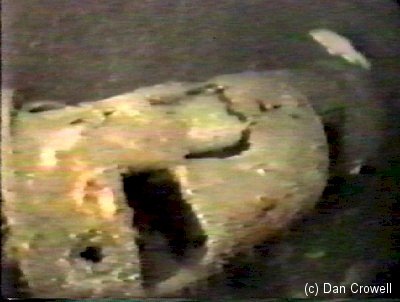U-869 (3/5)

Mystery U-Boat
by Captain Dan Crowell
An expedition on September 2, 1991, aboard the dive boat SEEKER left Manasquan inlet to examine one of thousands of lumps that litter the floor of the Atlantic along the East Coast. The boat pulled away from the dock at midnight for a five-hour journey across open ocean to a point 65 miles off the New Jersey coast. The trip is an annual event set aside from the usual schedule to investigate clues to a lump that may hold more promise of interest than an old trash barge or pile of rocks. These clues are usually obtained by trading locations with fishermen or dragger captains who wish to avoid these lumps so as not to lose their nets.

U-869 departs on her only cruise
As SEEKER neared its destination, Captain Bill Nagle - owner-operator of the boat - was called to the wheelhouse. The sun had just risen into a clear sky and the seas were tolerable as he took over the helm. On approach to the coordinates, Captain Bill slowed the engines and began a search pattern. Within a few minutes, an erratic jump on the bottom recorder traced an outline of an object resting on the bottom. The signal was given to toss the grapnel off the bow. The anchor line jerked back as the grapnel clambered over the wreckage then fetched up securely, and the line was quickly tied off.

A glance at the depth sounder revealed deeper water than anticipated. Captain John Chatterton decided to tie in the anchor line and make a reconnaissance dive. He quickly geared up then flopped over the side of the boat. Descending the anchor line, John reached the bottom and quickly secured the grapnel so it couldn't pull free of the wreckage. It was very dark and visibility was only 10 to 15 feet as he continued his survey. With light in hand illuminating only a small area John swam along what appeared to be the upper edge of the hull. He recalls noticing the top of the hull curved inward to meet the deck area, unlike a ship, which would have a gunwale that protrudes above the main deck. "Another barge, " he thought to himself.
Continuing he noticed a hatch and again it was unlike one found on a ship or barge. This one was built to withstand great pressure. Pictures started forming in John's mind as he surveyed the wreckage further. A high-pressure cylinder and narrow beam were revealed while swimming up over the wreck. The answer was soon unveiled. "It's a sub!" John excitedly looked for evidence to substantiate his discovery. Checking his gauges, the bottom timer indicated the dive was over and John reluctantly swam back to the anchor line.




Ascending the anchor line, John stopped at fifty feet to begin his lengthy decompression. As the divers on board waited impatiently, diver Kevin Brennan noticed John's bubbles close to the surface near the anchor line indicating he was decompressing. Kevin decided not to wait for John to surface. He donned his gear and splashed into the water. Kevin figured John would indicate whether or not there was anything of interest before he made the descent. When Kevin reached the anchor line John saw him and quickly scribbled something on his slate. As Kevin made his descent, John held out his slate: "SUB!" Kevin's eyes opened wide with excitement, then he ascended to alert the others of their impending dive. The remaining divers moved about in a frenzy to don their gear, each exuberant to be one of the first to dive a virgin wreck. The excitement must have been too much that day for not one artifact was recovered to give any clue of the wreck's origin.
The next trip proved unproductive and ended in tragedy. A diver, [ Steven Feldman ] for reasons unknown, was rendered unconscious and swept away in the current. He was not recovered until several months later, far from the wreck, by a commercial fisherman. Diver John Yurga did recover the first artifacts that day but they added no immediate evidence to the wreck's identity.
As the weeks passed between trips much research was underway. This also proved fruitless as to the origin of the wreck. No naval records showed the sinking of any submarine within hundreds of miles of the wreck's location. Though the records showed no sinkings they did reveal the bombing of anything that even remotely resembled a shadow below the surface of the water by naval and civil defenses. We theorized that in at least one case, this method to defend against a U-boat attack was more than effective. Through conjecture, our opinion was formed that the wreck was of German origin.
The third trip was greatly rewarding. John Chatterton, Steve Gatto, and I all recovered artifacts that would confirm the wreck as being German. I recovered items from one of the survival canisters with operational instructions written in German. Steve Gatto recovered a part of U.Z.O., a torpedo aiming device with the Kreigsmarine insignia stamped into it. John recovered china from deep inside the wreck. Not only did the china have the Kriegsmarine insignia but also the date, 1942. John's find narrowed the field of research considerably but the definitive answer to the mystery remained elusive.


On the fourth and final trip of the 1991 season, many more artifacts were recovered. One, in particular, may hold the key to unlock the mystery. A knife with a name crudely inscribed in the handle was recovered by Chatterton near the same area as the china. Though the wreck holds no real archaeological value or treasure, the thrill of discovery and exploration is more than enough reward to justify the time, expense, and risk of those experienced and daring individuals willing to be part of the adventure.
reprinted from Sub Aqua Journal September 1992
Photos courtesy of Dan Crowell

